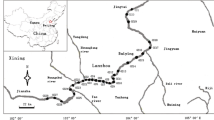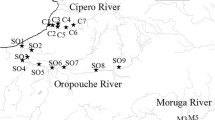Abstract
The concentrations of Cd, Cr, Cu, Ni, Pb and Zn were determined in the water and surface sediments from the Henan reaches of the Yellow River. Twenty-three sampling sites along the Yellow River and its tributaries were selected. Generally, metal concentrations were found to decrease in sequences of Zn > Cu > Pb > Cr > Ni > Cd in water and Zn > Cr > Pb > Ni > Cu > Cd in sediments. High levels of metal concentration were determined at a few stations of the river and its tributaries, such as Yiluo River, Si River and Qin River. The pollution of the Yellow River by Cd, Cr, Cu, Ni, Pb and Zn can be regarded as much higher compared to the background values, US EPA criteria (1999) and China water quality criteria (2002). For sediments, metal levels except Pb did not significantly exceed the average shale levels and backgrounds in several countries including China. Data analysis manifests that positive correlations were found between Cu, Ni and Zn in water, and Pb, Ni, Zn and Cr in sediments. The Pearson correlation coefficient analysis and Cluster analysis were provided to assess the possible contamination sources. The results indicate a general appearance of serious pollution along the banks of the Yellow River. The wastewaters discharged by the mine plants, smelter plants, power plants, battery plants, tannery plants, etc., and sewage inputs from the cities along the river banks may be the sources of metals.
Similar content being viewed by others
References
Bulletin of Water Resources of the Yellow River for 2007. The Yellow River Conservancy Commission, Zhengzhou, 2007
Xia XH, Zhou JS, Yang ZF. Nitrogen contamination in the Yellow River Basin of China. J Environ Quality, 2002, 31(3): 917–925
Főrstner U, Wittman GTW. Metal Pollution in the Aquatic Environment. Berlin: Springer-Verlag, 1983
Gorenc S, Kostaschuk R, Chen Z. Spatial variations in metals on tidal flats in the Yangtze Estuary, China. Environ Geology, 2004, 45(8): 1101–1108
Li X, Wai OWH, Li YS, Coles BJ, Ramsey MH. Thornton L. Metal distribution in sediment profiles of the Pearl River estuary, South China. Appl Geochem, 2000, 15(5): 567–581
Huang H, Ou WH, Wang LS. Semivolatile organic compounds, organochlorine pesticides and metals in sediments and risk assessment in Huaihe River of China. J Environ Sci, 2006, 18(2): 236–241
Sin SN, Chua H, Lo W, Ng LM. Assessment of metal cations in sediments of Shing Mun River, Hong Kong. Environ Int, 2001, 26(5–6): 297–301
Olivares-Rieumont S, De La Rosa D, Lima L, Graham DW, Alessandro KD, Borroto J, Martínez F, Sánchez J. Assessment of metal levels in Almendares River sediments-Havana City, Cuba. Water Res, 2005, 39(16): 3945–3953
Singh KP, Mohan D, Singh VK. Malik A. Studies on distribution and fractionation of metals in Gomti river sediments-a tributary of the Ganges, India. J Hydrology, 2005, 312(1–4): 14–27
Woitke P, Wellmitz J, Helm D, Kube P, Lepom P, Litheraty P. Analysis and assessment of metal pollution in suspended solids and sediments of the river Danube. Chemosphere, 2003, 51(8):633–642
Qu WC, Kelderman P. Metal contents in the Delft canal sediments and suspended solids of the River Rhine: multivariate analysis for source tracing. Chemosphere, 2001, 45(6–7), 919–925
Okonkwo JO, Mothiba M. Physico-chemical characteristics and pollution levels of metals in the rivers in Thohoyandou, South Africa. J Hydrology, 2005, 308(1–4): 122–127
Miller NJ, Miller JC. Statistic and Chemometrics for Analytical Chemistry, 4th ed. New York: Prentice Hall, 2001
Klavins M, Briede A, Rodinov V, Kokorite I, Parele E, Klavina I. Metals in rivers of Latvia. Sci Total Environ, 2000, 262(1/2): 175–183
State environmental protection administration of China. China environmental quality standards for surface water GB3838-2002, 2002. 2
US EPA. National Recommended Water Quality Criteria Correction of Water. 1999, EPA v822-Z-99-001, 25
Alonso A, Santos M, Callejón M, Jiménez JC. Speciation as a screening tool for the determination of metal surface water pollution in the Guadiamar river basin. Chemosphere, 2004, 56: 561–570
Khazheeva ZI, Urbazaeva SD, Bodoev NV, Radnaeva LD, Kalinin YO. Metals in the water and bottom sediments of the Selenga River Delta. Water Resour, 2004, 31(1): 69–72
Cymerman SA, Kerpers AJ. Concentrations of metals and plant nutrients in water, sediments and aquatic macrophytes of anthropogenic lakes (former open cut brown coal mines) differing in stage of acidification. Sci Total Environ, 2001, 281: 87–98
Turekian KK, Wedepohl KH, Distribution of elements in some major units of the earth’s crust. Geologic Soc Am Bull, 1961, 72:175–192
Background Value of Soil Element, China. National Environmental Protection Bureau and China Environmental Monitoring Center. Beijing: China Environmental Science Press, 1990
Grosbois CA, Horowitz AJ, Smith JJ, Elrick KA. The effect of mining and related activities on the sediment trace element geochemistry of Lake Coeur D’Alene, Idaho, USA. Part III: the Spokane River Basin. Hydrologic Processes, 2001, 15(5): 855–875
Akcay H, Oguz A, Karapire C. Study of metal pollution and speciation in Buyuk Menderes and Gediz River sediments. Water Res, 2003, 37(4): 813–822
Enguix GA, Ternero RM, Jiménez Sá JC, Fernández Espinosa AJ; Barragán de la Rosa FJ. Assessment of metals in sediments in a tributary of Guadalquiver River (Spain), metal partitioning and relation between the water and the sediment system. Water, Air Soil Pollut, 2000, 121(1–4): 11–29
Santschi PH, Presley BJ, Wade TL, Garcia-Romero B, Baskaran M. Historical contamination of PAHs, PCBs, DDTs and heavy metals in Mississippi River Delta, Galveston Bay and Tampa Bay sediment cores. Marine Environ Res, 2001, 52(1): 51–79
Yang Z, Wang Y, Shen Z, Niu J, Tang Z. Distribution and speciation of heavy metals in sediments from the mainstream, tributaries, and lakes of the Yangtze River catchment of Wuhan, China. J Hazard Mater, 2009, 166(2-3): 1186–1194
Avila-Pérez P, Balcázar M, Zarazúa-Ortega G, Barceló-Quintal I, Díaz-Delgado C. Metal concentrations in water and bottom sediments of a Mexican reservoir. Sci Total Environ, 1999, 234(1–3): 185–196
Livingstone DJ. Data analysis for chemists: application to QSAR and chemical product design. London: Oxford University Press, 1995
Author information
Authors and Affiliations
Corresponding author
Rights and permissions
About this article
Cite this article
Feng, J., Wang, G., Sun, J. et al. Metals in water and surface sediments from Henan reaches of the Yellow River, China. Sci. China Chem. 53, 1217–1224 (2010). https://doi.org/10.1007/s11426-010-0089-9
Received:
Accepted:
Published:
Issue Date:
DOI: https://doi.org/10.1007/s11426-010-0089-9




